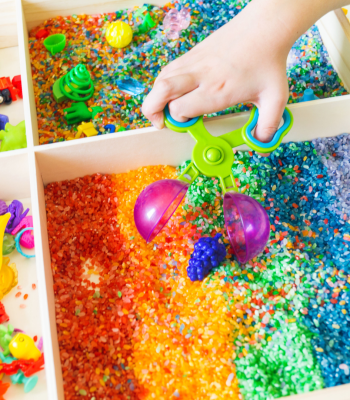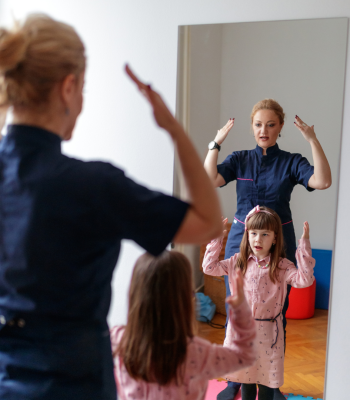Summary
Body awareness exercises for autistic people can help them develop a better understanding of their internal sensations and emotions. These exercises can be adapted to each person's interests and sensory preferences, so look for teachable moments in your daily routines and preferred work, leisure, or play activities.
What is Interoception?
Many of us understand and explore the world through the five senses: touch, smell, taste, sight, and hearing. But there’s another important sense called interoception. This sense helps us become aware of signals from inside our body, like feeling our heartbeat, noticing when we’re hungry, or realizing we need to use the bathroom.
Interoception means feeling and making sense of (sensing) messages from inside our body, like when our stomach tells us it’s time for a snack, or when our heart starts to race. We don’t focus on these messages all the time, but there are moments, like when we have to speak or present in front of the class, or when we’ve seen something scary on television, or have been very late for something important, that we might feel our heart thumping really hard. Different parts of our brain keep an eye on these inner signals, making sure everything is working well and trying to give us awareness (giving us a heads-up) in case we need to make a change, like get a snack, take a break, or use the bathroom.
Think of it this way: your brain acts as a helpful guide, noticing things like when you might need a drink because you’re getting a bit thirsty. It’s like your body’s alarm system, making sure everything stays just right. The balance – when things are all working right – is called homeostasis. It’s the way our body works to keep us healthy, safe, and feeling comfortable, almost the same as when we sweat to cool down if we’re too warm. For some, awareness and response are automatic, but for others, there can be a disconnect. Body awareness exercises can help develop better interoception and lead to homeostasis – a best state of health and safety.
Body Awareness Exercises for Autistic People
Body awareness exercises for autistic people can help them develop a better understanding of their internal sensations and emotions. These exercises can be adapted to interests and sensory preferences, so look for teachable moments in your daily routines and preferred play activities.
Sensory Exploration – Outside In
External sensory experiences have an impact on what happens internally. When engaging in sensory exploration, be mindful of how each activity either calms or excites you.
- Use textured materials like fabrics, sponges, or sensory balls.
- Dig into sensory bins. Note how the textures and movement feel, and notice its calming effects.
- Explore different textures (sand, playdough, textured fabrics) and discuss how each texture feels against the skin.
- Engage in mindful eating activities, paying close attention to the tastes, textures, and sensations while eating.
- Lie down on a large sheet of paper and have someone trace your body outline. Then, color or label different sensations you feel in each body part.
- What’s that smell? Choose favorite scents and talk about how the fragrances make you feel.

Movement Games
- Simon Says: Play a game of Simon Says with movement commands that target specific body parts (touch your toes, clap your hands).
- Dance or Follow-the-Leader: Encourage imitation of various movements and poses.
- Lie down or sit comfortably and guide attention to different body parts, and notice sensations, tension, or relaxation.
- Child-friendly yoga poses that focus on different body parts, such as Tree Pose, Cat-Cow, and Bridge Pose, can promote body awareness.
- Tense and relax different muscle groups while discussing how it feels to tense and then release the tension.

Mirror Activities and Emotions
- Stand in front of a mirror and make faces to recognize facial expressions associated with different emotions. Imitate your mirror partner’s gestures and expressions.
- Mimic different body movements and gestures to increase self-awareness.
- Act out different emotions and discuss the physical sensations associated with each emotion.
- Use a visual “emotion thermometer” to help identify and rate your current emotional state and associated physical sensations.
- Guide someone, or have someone guide you, through a calming and sensory-rich imaginary experience, such as walking on a sandy beach or exploring a forest.

Breathing Exercises
- Inhale slowly through the nose, imagining inflating a balloon in the belly, and exhale through the mouth to deflate the balloon.
- Hold a feather close to the nose and practice inhaling and exhaling gently to make the feather move.
- Place a small object (feather or cotton ball) on your stomach and breathe in and out to make the object move.
- Blow bubbles

Interoception and Occupational Therapy (OT)
Occupational therapy (OT) for interoception involves structured interventions and activities designed to enhance awareness and understanding of internal bodily sensations.
Assessment and Baseline: Begin with an assessment to determine current level of interoceptive awareness and identify specific areas of difficulty. This baseline will guide the development of a tailored intervention plan.
Education: Provide information about interoception and its importance. Communicate that internal sensations provide valuable information about their body’s needs and emotional states.
Individualized Goals: Collaborate to set interoception-related goals and track progress over time.
Communication Skills: Learn to communicate internal states to others. This is particularly important for people who struggle to express their needs or discomfort.
Visual Supports: Use visual aids, charts, or diagrams to help understand and express internal sensations.
Biofeedback: Use biofeedback devices to visually or audibly represent physiological processes like heart rate or breath. This helps make the connection between internal sensations and these processes.
Hygiene Routines: During hygiene activities, notice how different sensations change during tasks like brushing teeth, washing hands, or taking a shower.
Environmental Sensations: Explore different sensory experiences in the environment, such as temperature changes or textured surfaces, and discuss how these sensations affect the body.
Mindfulness Practices: Incorporate mindfulness techniques, such as body scans and mindful breathing, to help focus on internal sensations and recognize changes as they occur.
Emotion Regulation: Teach emotional awareness and regulation strategies. Identify bodily cues associated with different emotions and develop coping skills to manage emotional responses.
Social Interaction Activities: Incorporate activities that involve social interactions, helping to recognize and respond to social cues related to emotions and bodily states.
Daily Journals: Keep a daily journal to record experiences, emotions, and bodily sensations. This practice promotes self-reflection and awareness.
Interoceptive Challenges: Gradually introduce activities that challenge interoceptive awareness, such as eating spicy foods, engaging in physical activities, or meditating.
Visit the OT Toolbox – What You Need to Know about Interoception
Interoception is often referred to as the “hidden sense,” and this hidden sense helps us understand body signals, like hunger, thirst, and emotional states. This self-awareness fosters a sense of well-being and it can help us communicate needs more effectively. By honing interoceptive skills, we can help recognize and manage internal messages, leading to greater self awareness and self regulation.

